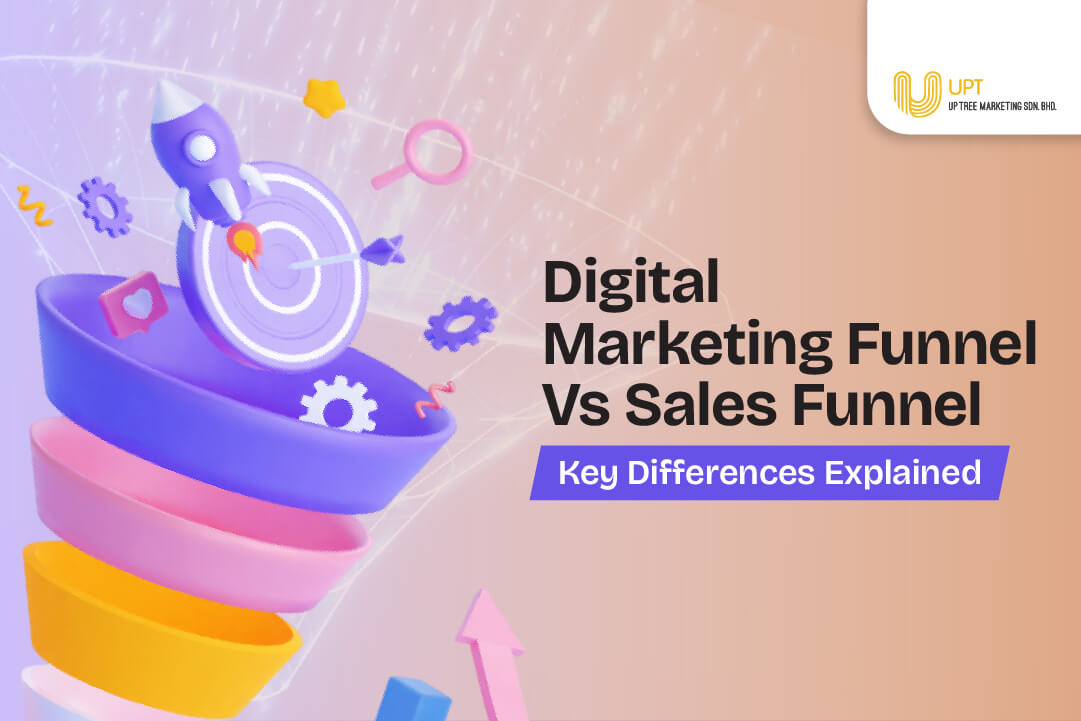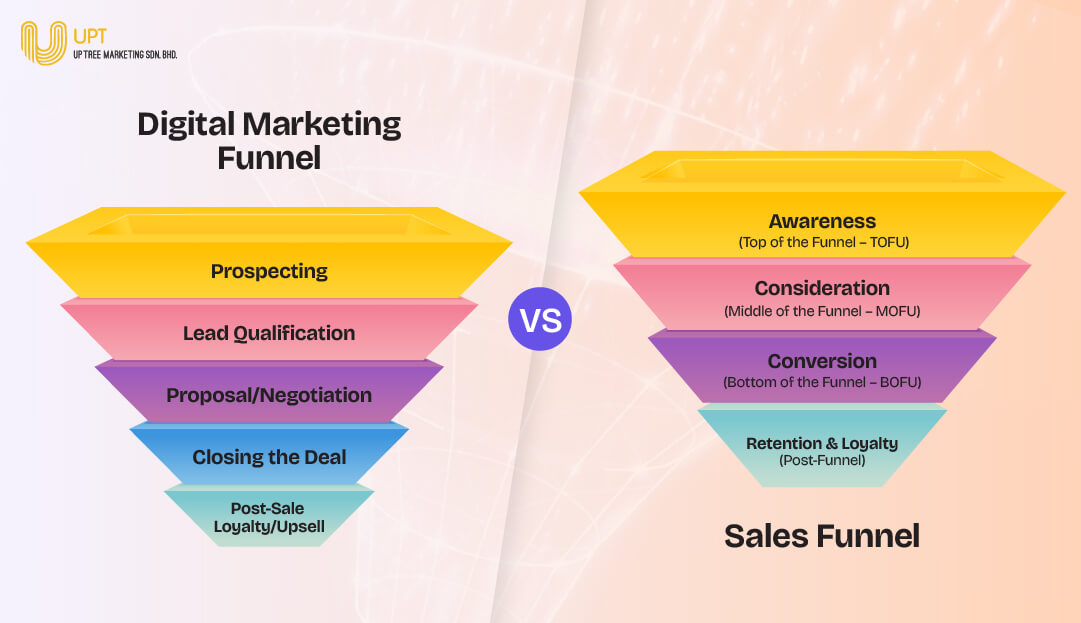Discover the difference between the digital marketing funnel and the sales funnel. Learn how each stage—from awareness to conversion—drives customer engagement, boosts conversions, and aligns marketing with sales.

Introduction
In today’s competitive business landscape, understanding your customer journey is more important than ever. That’s where the digital marketing funnel and the sales funnel come into play.
Both funnels aim to convert prospects into loyal customers, but they work in different ways. While the digital marketing funnel focuses on building awareness and nurturing leads through online touchpoints like SEO, social media, and email marketing, the sales funnel zeroes in on closing deals and driving revenue.
So, what sets them apart—and why should your business care? Let’s break it down.
What Is a Digital Marketing Funnel?
A digital marketing funnel is a model that illustrates how potential customers move from discovering your brand to becoming repeat buyers and advocates.
Unlike traditional funnels, the digital version is non-linear—customers may skip stages, go back, or interact with multiple touchpoints before making a purchase.
Key Characteristics:
✅ Centers on building long-term trust and relationships
✅ Relies on digital channels like SEO, social media, paid ads, and content marketing
✅ Emphasizes nurturing rather than hard selling

Key Stages of a Digital Marketing Funnel
1. Awareness (Top of the Funnel – TOFU)
✅ Goal: Attract a broad audience and introduce your brand.
✅ Strategies: SEO, content marketing (blogs, social media), paid ads, videos.
2. Consideration (Middle of the Funnel – MOFU)
✅ Goal: Nurture interest and build trust by providing value.
✅ Strategies: Product guides, email sequences, gated content (eBooks, webinars), problem-solving blog posts.
3. Conversion (Bottom of the Funnel – BOFU)
✅ Goal: Drive users to purchase or take a desired action.
✅ Strategies: Clear CTAs, free trials, special offers, and a smooth checkout process.
4. Retention & Loyalty (Post-Funnel)
✅ Goal: Keep customers engaged and encourage repeat business.
✅ Strategies: Follow-ups, loyalty programs, personalized recommendations, post-purchase experiences.
📌 Example: A prospect finds your blog through Google (TOFU), downloads your webinar (MOFU), signs up for a free trial (BOFU), and later joins your loyalty program (Retention).Example: A prospect finds your blog through Google (TOFU), downloads your webinar (MOFU), signs up for a free trial (BOFU), and later joins your loyalty program (Retention).
What Is a Sales Funnel?
The sales funnel is focused on moving qualified leads closer to a purchase decision through direct interaction and personal touch.
Unlike the marketing funnel, which is broader, the sales funnel is narrower, targeting leads that are already aware of your business.
Key Characteristics:
✅ Short-term, deal-oriented process
✅ Managed by sales teams with a hands-on approach
✅ Relies on demos, consultations, proposals, and negotiations
Stages of the Sales Funnel
1. Prospecting – Identifying potential leads from marketing or outbound efforts.
2. Lead Qualification – Determining if the lead has the budget, need, and authority to buy.
3. Proposal/Negotiation – Sharing solutions, offers, or contracts.
4. Closing the Deal – Securing the purchase (win or loss).
5. Post-Sale Loyalty/Upsell – Encouraging repeat purchases or higher-value packages.
📌 Example: A lead downloads your whitepaper (from the digital funnel), gets contacted by sales, attends a demo, negotiates pricing, and signs a contract.
Digital Marketing Funnel vs Sales Funnel: Key Differences
| Aspect | Digital Marketing Funnel | Sales Funnel |
| Purpose | Build awareness, educate, nurture relationships | Convert qualified leads into paying customers |
| Interaction | Broad, automated, content-driven | Personal, direct, human-to-human |
| Timeline | Longer-term, nurtures prospects over time | Shorter-term, focused on closing deals |
| Metrics | Traffic, engagement, leads, CTR, conversions | Close rate, deal size, CAC (Customer Acquisition Cost) |
| Tactics | SEO, blogs, social media, email, webinars | Calls, demos, proposals, negotiations |
Why Both Funnels Matter
It’s not about choosing one over the other. Instead, businesses should align both funnels for maximum impact.
✅ The digital marketing funnel warms up leads, educates them, and builds trust.
✅ The sales funnel takes over when prospects are ready to engage personally and make purchasing decisions.
✅Together, they create a seamless customer journey that boosts conversions and improves ROI.
Conclusion
The digital marketing funnel is about nurturing relationships through awareness, education, and engagement, while the sales funnel focuses on personalized interactions to close deals.
When combined, these two funnels create a powerful strategy: marketing generates and qualifies leads, while sales converts them into loyal customers.
By understanding both, your business can bridge the gap between marketing and sales, creating smoother journeys, happier customers, and stronger revenue growth.
Supporting Source Link:https://www.clearvoice.com/resources/marketing-funnel-vs-sales-funnel/
Share now: